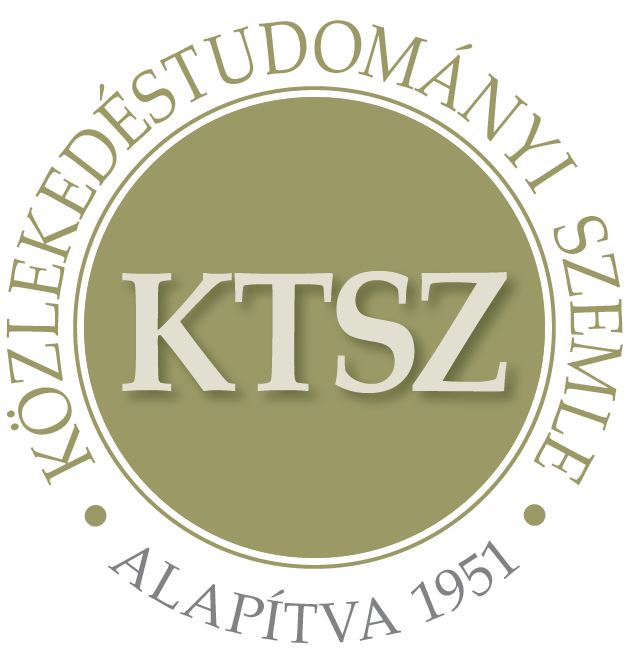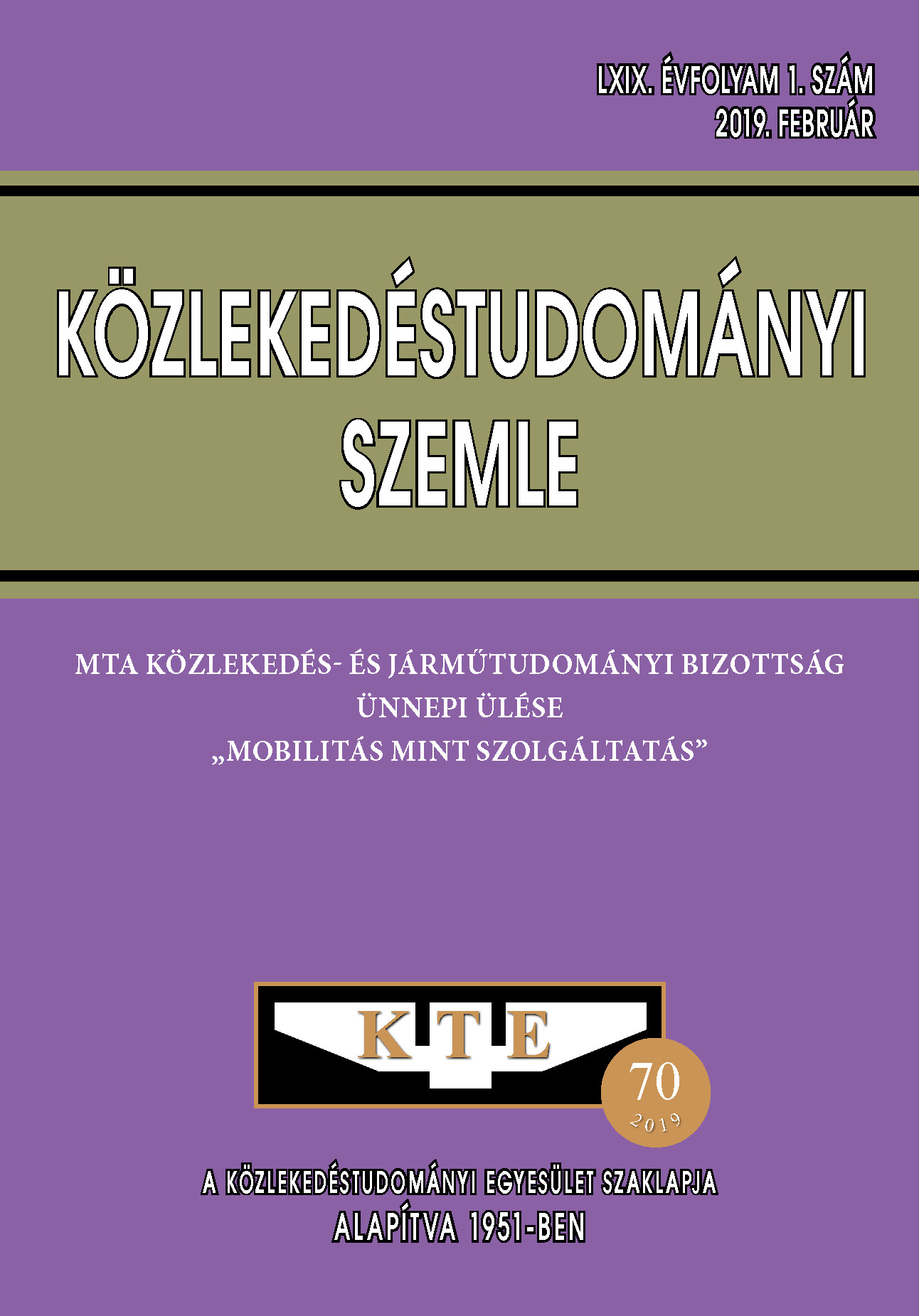The Planning and Operation of Electromobility and Mobility Services based On Autonomous Vehicles
Abstract
The mobility services supporting the use of electric and autonomous (driverless) vehicles are getting more and more attention because of the developments in the field of vehicle technology, energetics and infocommunication. Technology development is often the tool of tackling social and sustainability challenges; however, it also generates other challenges. Transport modes, travel behaviour, built environment and the infrastructure of transport, energetics and telematics are altering. The emerging various and combined forms of services
require more complex and novel approaches in the field of system planning and operation more than ever. The paper summarizes the principles and best practices of planning and operation of electric and autonomous vehicle related mobility services with a system approach focusing on the processes and the estimated most significant effects. Operational and user aspects are also considered. The paper is based on the recent scientific results.
References
Szalay, Zs., Nyerges, Á., Hamar, Zs., Hesz, M. (2017) Technical Specification Methodology for an Automotive Proving Ground Dedicated to Connected and Automated Vehicles. Periodica Polytechnica Transportation Engineering. Vol. 45. No. 3. pp. 168-174. DOI: http://doi.org/cxk3
Csiszár, Cs., Csonka, B., Földes, D. (2019) Innovative Passenger Transportation Systems könyv, Akadémia Kiadó, Budapest, ISBN 978 963 059 941 2
Gong, L., Fu, Y., Li, Z. (2016) Integrated planning of BEV public fast-charging stations. The Electricity Journal. Vol. 29. No. 10. pp. 62-77. DOI: http://doi.org/ch7s
Upchurch, C., Kuby, M. (2010) Comparing the p-median and flow-refueling models for locating alternative-fuel stations. Journal of Transport Geography. Vol. 18. pp. 750-758. DOI: http://doi.org/d9pk5x
Shirmohammadli, A., Vallée, D. (2017) Developing a location model for fast charging infrastructure in urban areas. International Journal of Transport Development and Integration. Vol. 1. No. 2. pp. 159-170. DOI: http://doi.org/cxk4
Zhuangli, H., Canbing, L., Yijia C., Baling, F., Lina, H., Mi, Z. (2014) How Smart Grid Contributes to Energy Sustainability. Energy Proceida. Vol. 61. pp. 858-861. DOI: http://doi.org/cxk5
Sulabh, S., Nadia, A. (2018) Stochastic charging of electric vehicles in smart power distribution grids. Sustainable
Cities and Society. Vol. 40. pp. 91-100. DOI: http://doi.org/cxk6
Csepinszky, A., Giustiniani, G., Holguin, C., Parent, M., Falment, M., Alessandrini, A. (2017) Safe Integration of Fully Automated Road Transport Systems in Urban Environments: The Basis for the Missing Legal Framework. Transportation Research Record: Journal of the Transportation Research Board. Vol. 2489. DOI: http://doi.org/cxk7
Krueger, R., Rashidi, T.H., Rose, J.M. (2016) Preferences for shared autonomous vehicles. Transportation Research Part C: Emerging Technologies. Vol. 69. pp. 343–355. DOI: http://doi.org/f84c8b
Zhang, R., Spieser, K., Frazzoli, E., Pavone, M. (2015) Models, algorithms, and evaluation for autonomous Mobilityon-demand systems. American Control Conference (ACC), July, Chicago, USA. DOI: http://doi.org/cxk8
Csiszár, Cs., Földes, D. (2018) Operational Model and Impacts of Mobility Service based on Autonomous Vehicle.
nternational Conference on Traffic and Transport Engineering (ICTTE), 17-28 September, Belgrade, Serbia
Gruel, W., Stanford, M. (2016) Assessing the long-term effects of autonomous vehicles: a speculative approach.
Transportation Research Procedia. Vol. 13. pp. 18-29. DOI: http://doi.org/gdgzxs
Waldrop, M.M. (2015) Autonomous vehicles: no drivers required. Nature. Vol. 518. No. 7537. pp. 20-23. DOI: http://doi.org/gfgq87
Pereira, A.M., Anany, H., Pribyl, O., Prikryl, J. (2017) Automated Vehicles in Smart Urban Environment: A Review.
Smart City Symposium (SCSP), 25-26 May, Prague, Czech Republic DOI: http://doi.org/cxk9
Articles published electronically are open access (OJS), freely available online and can be downloaded. Authors of articles are not charged any publication or publishing costs (APC). Users have the right to read, download, copy, print, and search the articles, or share the full text with a link.
Authors must declare that their submission has not been previously published in another journal, that financial support has been acknowledged, and that the list of references is complete and accurate, including specification of URLs and DOIs (if available). When submitting a draft article, each author approves the submitted version. Authors guarantee that the article is their original work. Authors are required to participate in the peer review process, follow the advice of reviewers, meet the prescribed deadlines, and, if any, withdraw the submission or correct errors.
All submitted articles are subject to peer review, where the editors request an independent evaluation from at least one expert, ensuring that the reviewer(s) have no conflicts of interest with the authors. The final decision is made by the Editor-in-Chief, who takes into account the evaluations and the suggestions of the editors. The editors and reviewers treat the submission confidentially.
The publisher and editors are committed to maintaining high ethical standards and to preventing publications that involve research misconduct. They follow the COPE guidelines on such ethical issues.
The authors retain copyright and grant the journal the right of first publication under the Creative Commons License (https://creativecommons.org/licenses/by-nc-nd/4.0), which allows others to share the work, while acknowledging the authorship of the work and the first publication in the journal.
The journal archives all published articles, and the journal's owner, the Hungarian Society of Transportation Sciences, will continue to operate the database even if the journal ceases to be published.















